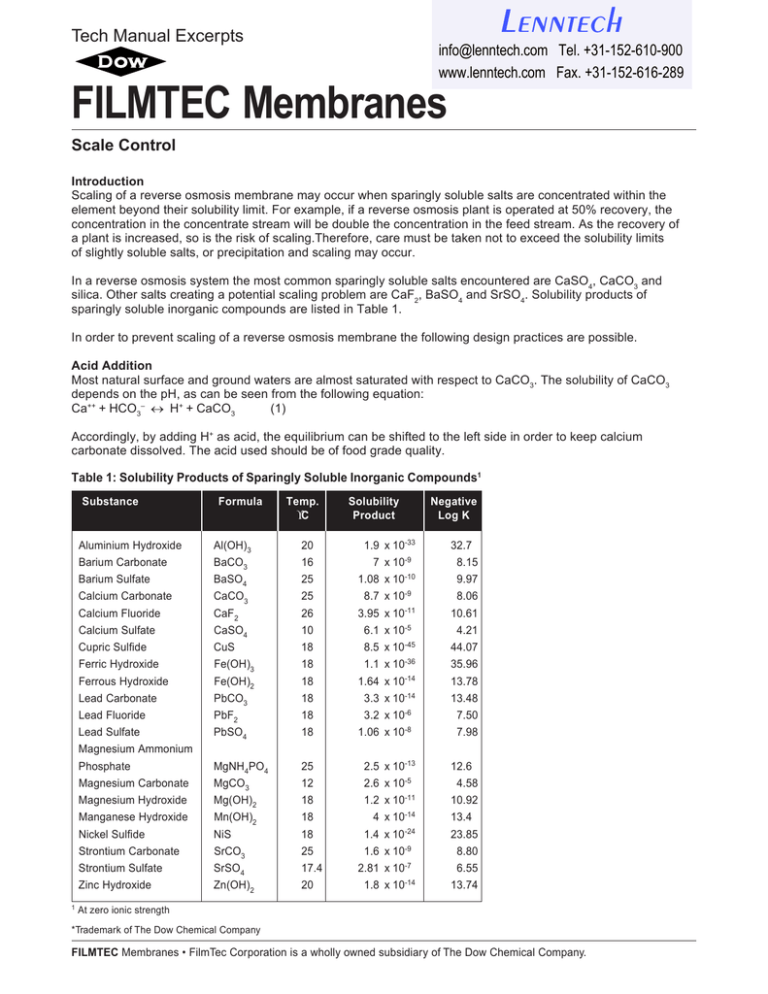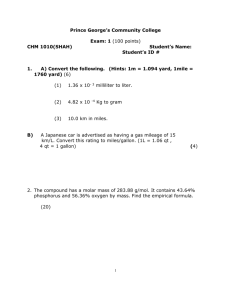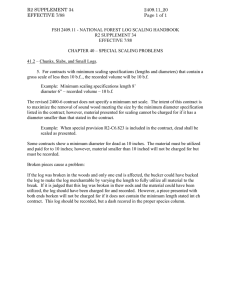FILMTEC Membranes Tech Manual Excerpts Scale Control
advertisement

Lenntech Tech Manual Excerpts info@lenntech.com Tel. +31-152-610-900 www.lenntech.com Fax. +31-152-616-289 FILMTEC Membranes Scale Control Introduction Scaling of a reverse osmosis membrane may occur when sparingly soluble salts are concentrated within the element beyond their solubility limit. For example, if a reverse osmosis plant is operated at 50% recovery, the concentration in the concentrate stream will be double the concentration in the feed stream. As the recovery of a plant is increased, so is the risk of scaling.Therefore, care must be taken not to exceed the solubility limits of slightly soluble salts, or precipitation and scaling may occur. In a reverse osmosis system the most common sparingly soluble salts encountered are CaSO4, CaCO3 and silica. Other salts creating a potential scaling problem are CaF2, BaSO4 and SrSO4. Solubility products of sparingly soluble inorganic compounds are listed in Table 1. In order to prevent scaling of a reverse osmosis membrane the following design practices are possible. Acid Addition Most natural surface and ground waters are almost saturated with respect to CaCO3. The solubility of CaCO3 depends on the pH, as can be seen from the following equation: Ca++ + HCO3– ↔ H+ + CaCO3 (1) Accordingly, by adding H+ as acid, the equilibrium can be shifted to the left side in order to keep calcium carbonate dissolved. The acid used should be of food grade quality. Table 1: Solubility Products of Sparingly Soluble Inorganic Compounds1 Substance Formula Temp. °C Solubility Product Aluminium Hydroxide Al(OH)3 20 1.9 x 10-33 Barium Carbonate BaCO3 16 7 x 10-9 Barium Sulfate BaSO4 25 Calcium Carbonate CaCO3 25 1.08 x 10-10 8.7 x 10-9 3.95 x 10-11 Negative Log K 32.7 8.15 9.97 8.06 Calcium Fluoride CaF2 26 Calcium Sulfate CaSO4 10 6.1 x 10-5 10.61 4.21 Cupric Sulfide CuS 18 8.5 x 10-45 44.07 Ferric Hydroxide Fe(OH)3 18 1.1 x 10-36 35.96 Ferrous Hydroxide Fe(OH)2 18 1.64 x 10-14 13.78 Lead Carbonate PbCO3 18 3.3 x 10-14 13.48 10-6 7.50 1.06 x 10-8 7.98 Lead Fluoride PbF2 18 Lead Sulfate PbSO4 18 3.2 x Phosphate MgNH4PO4 25 2.5 x 10-13 Magnesium Carbonate MgCO3 12 2.6 x 10-5 Magnesium Ammonium Magnesium Hydroxide Mg(OH)2 18 Manganese Hydroxide Mn(OH)2 18 4 x 10-14 10-24 4.58 10.92 13.4 Nickel Sulfide NiS 18 1.4 x Strontium Carbonate SrCO3 25 1.6 x 10-9 8.80 Strontium Sulfate SrSO4 17.4 2.81 x 10-7 6.55 Zinc Hydroxide 1 1.2 x 10-11 12.6 Zn(OH)2 20 1.8 x 10-14 23.85 13.74 At zero ionic strength *Trademark of The Dow Chemical Company FILMTEC Membranes • FilmTec Corporation is a wholly owned subsidiary of The Dow Chemical Company. Sulfuric acid is easier to handle and in many countries more readily available than hydrochloric acid, but on the other hand, additional sulfate is added to the feed stream. This might be critical with respect to sulfate scaling. In order to avoid calcium carbonate scaling, CaCO3 should tend to dissolve in the concentrate stream rather than to precipitate. This tendency can be expressed by the Langelier Saturation Index (LSI) for brackish waters and the Stiff & Davis Stability Index (S&DSI) for sea waters. At the pH of saturation (pHS), the water is in equilibrium with CaCO3. The definitions of LSI and S&DSI are: LSI = pH - pHS (TDS <10,000 mg/l) (2) S&DSI = pH - pHS (TDS >10,000mg/l) (3) To control calcium carbonate scaling by acid addition alone, the LSI or S&DSI in the concentrate stream must be negative. If a high quality scale inhibitor is used, the LSI in the concentrate stream can be < 1.5. This will reduce or eliminate the acid consumption. Many inhibitors allow operation up to an LSI of < 1.8 in the concentrate. Please refer to the inhibitor manufacturer’s own literature for reference points. Scale Inhibitor Addition Scale inhibitors (antiscalants) can be used to control carbonate scaling, sulfate scaling and calcium fluoride scaling. Scale inhibitors have a “threshold effect”, which means that minor amounts adsorb specifically to the surface of microcrystals thereby preventing further growth and precipitation of the crystals. The most widely used scale inhibitor is sodiumhexametaphosphate (SHMP). Food grade quality should be used. Care has to be taken in order to avoid hydrolysis of SHMP in the dosing feed tank. Hydrolysis would not only decrease the scale inhibition efficiency, but also create a calcium phosphate scaling risk. SHMP should be dosed to give a concentration in the concentrate stream of 20 mg/l. For example, the dosage into the feed stream of a system with 75% recovery will be 5 mg/l. Polymeric organic scale inhibitors are more effective than SHMP. However, precipitation reactions may occur with cationic polyelectrolytes or multivalent cations, e.g. aluminium or iron. The resulting gumlike products are very difficult to remove from the membrane elements. For dosage rates please contact the antiscalant manufacturers. Overdosing should be avoided. In RO plants operating on sea water with TDS in the range of 35,000 mg/l, scaling is not such a problem as in brackish water plants, because the recovery of sea water plants is limited by the osmotic pressure of the concentrate stream to 30-45%. However, for safety reasons we recommend using a scale inhibitor when operating above a recovery of 35%. Softening with a Strong Acid Cation Exchange Resin The scale forming cations such as Ca++, Ba++, Sr++ are removed and replaced by sodium cations. The resin has to be regenerated with NaCl at hardness breakthrough. The pH of the feed water is not changed by this treatment. Therefore, no degassifier is needed. Only a little CO2 from the raw water is present that can pass into the permeate creating a conductivity increase there. One can even lower the permeate conductivity by adding some NaOH to the softened feed water (up to pH 8.2) in order to convert residual carbon dioxide into bicarbonate which is then rejected by the membrane. The rejection performance of the FT30 membrane is optimal at the neutral pH range. With DOWEX* ion exchange resins, the removal efficiency for Ca++, Ba++ and Sr++ is > 99.5%, which usually eliminates any risk of carbonate or sulfate scaling. Softening with a strong acid cation exchange resin is very effective and safe, provided the regeneration is done properly. It is used mainly in small or medium size brackish water plants, but not in sea water plants. A drawback of this process is its relatively high sodium chloride consumption, which might cause an environmental or an economic problem. With DOWEX* MONOSPHERE* ion exchange resins and a countercurrent regeneration technique, for example UPCORE*, it is possible to minimize the sodium chloride consumption to 110% of the stoichiometrical value. Dealkalization with a Weak Acid Cation Exchange Resin Dealkalization with a weak acid cation exchange resin is used mainly in large brackish water plants for partial softening in order to minimize the consumption of regeneration chemicals. In this process, only Ca++, Ba++ and Sr++ linked to bicarbonate (temporary hardness) are removed and replaced by H+, thus lowering the pH to 4-5. As the acidic groups of the resin are carboxylic groups, the ion exchange process stops when the pH reaches a value of 4.2, where the carboxylic groups are no longer dissociated. Therefore, it is only a partial softening. Only those scale forming cations are removed which are bound to bicarbonate. Therefore, this process is ideal for waters with a high bicarbonate content. The bicarbonate is converted into carbon dioxide: HCO3– + H+ ↔ H2O + CO2 (4) In most cases, carbon dioxide is not desired in the permeate. It can be removed by degassing either in the permeate or in the feed stream. Degassing the permeate is favored where a potential for biofouling is suspected (surface waters, high TOC, high bacteria counts). A high CO2 concentration on the membranes helps to keep bacteria growth low. Degassing the feed is preferred when optimum salt rejection is the priority. Removing CO2 also leads to an increase in pH (see equation (4)), and at pH > 6 the rejection is better than at pH < 5. The advantages of dealkalizing with a weak acid cation exchange resin are: • For regeneration, acid of not more than 105% of the stoichiometrical value is needed. This minimizes the operating costs and the environmental impact. • The TDS value of the water is reduced by the removal of bicarbonate salts. Accordingly, the permeate TDS value is also lower. The disadvantages are: • Residual hardness. If a complete softening is required, a sodium exchange process with a strong acid cation exchange resin can be added, even in one vessel. The overall consumption of regeneration chemicals is still lower than softening with a strong acid cation exchange resin alone. Due to the higher investment costs however, this combination will only be attractive for plants with high capacity. Another possibility to overcome this drawback of incomplete softening is to dose an antiscalant into the dealkalized water. Although we have so far never encountered scaling problems with waters dealkalized by weak acid cation exchange alone, we strongly recommend to calculate the solubilities of the residual sparingly soluble salts and to take the respective measures. • Variable pH of the treated water. The pH of the dealkalized water ranges from 3.5 to 6.5 depending on the degree of exhaustion of the resin. This cyclic pH variation makes it difficult to control the salt rejection of the plant. At pH < 4.2, the passage of mineral acid may increase the permeate TDS. It is therefore recommended to use more than one filter in parallel and to regenerate them at different times in order to level out the pH. Other possibilities to avoid extremely low pH values are CO2 removal or pH adjustment by NaOH afterwards. Lime Softening Lime softening can be used to remove carbonate hardness by adding hydrated lime: Ca(HCO3)2 + Ca(OH)2 → 2 CaCO3 + 2 H2O (5) Mg(HCO3)2 + 2 Ca (OH)2 → Mg(OH)2 + 2 CaCO3 + 2H2O (6) The noncarbonate calcium hardness can be further reduced by adding sodium carbonate (soda ash): CaCl2 + Na2CO3 → 2 NaCl + CaCO3 (7) The lime-soda ash process can also be used to reduce the silica concentration. When sodium aluminate and ferric chloride are added, the precipitate will include calcium carbonate and a complex with silicic acid, aluminium oxide and iron. With the hot lime silicic acid removal process at 60-70°C, silica can be reduced to 1 mg/l by adding a mixture of lime and porous magnesium oxide. With lime softening, barium, strontium and organic substances are also reduced significantly. The process requires a reactor with a high concentration of precipitated particles serving as crystallization nuclei. This is usually achieved by upflow solids-contact clarifiers. The effluent from this process needs media filtration and pH adjustment prior to the RO elements. Iron coagulants with or without poly-meric flocculants (anionic and nonionic) may be used to improve the solid-liquid separation. Lime softening should be considered for brackish water plants larger than 200 m3/h (880 gpm). More details are described in the literature. Preventative Cleaning In some applications, scaling is controlled by preventive membrane cleaning. This allows the system to run without softening or dosage of chemicals. Typically, those systems operate at low recovery in the range of 25%, and the membrane elements are replaced after 1-2 years. Accordingly, those systems are mainly small singleelement plants for potable water from tap water or sea water. The simplest way of cleaning is a forward flush at low pressure by opening the concentrate valve. Short cleaning intervals are more effective than long cleaning times, e.g. 30 seconds every 30 minutes. Cleaning can also be carried out with cleaning chemicals. In batch processes like in waste water treatment it is common practice to clean the membranes after every batch. The cleaning procedure, cleaning chemicals and the frequency of cleaning, has to be determined and optimized case by case. Special care has to be taken not to allow a scaling layer to develop in the course of time. Adjustment of Operating Variables When other scale control methods do not work, the operating variables of the plant have to be adjusted in such a way that scaling will not occur. The precipitation of dissolved salts can be avoided by keeping their concentration below the solubility limit, that means by reducing the system recovery until the concentrate concentration is low enough. Solubility depends also on temperature and pH. In the case of silica, increasing temperature and pH increases its solubility. Silica is usually the only reason for considering adjustment of operating variables as a scale control method, because these adjustments have economic drawbacks (energy consumption) or other scaling risks (CaCO3 at high pH). For small systems, a low recovery combined with a preventive cleaning program might be a convenient way to control scaling. The technical information contained here is extracted from the FILMTEC Membranes - Technical Manual. References to other sections of the manual have been replaced with short references to additional but separate information available from our web site. The information in these extracts has been updated and supercedes that contained in the full manual. Notice: No freedom from any patent owned by Seller or others is to be inferred. Because use conditions and applicable laws may differ from one location to another and may change with time, Customer is responsible for determining whether products and the information in this document are appropriate for Customerís use and for ensuring that Customerís workplace and disposal practices are in compliance with applicable laws and other governmental enactments. Seller assumes no obligation or liability for the information in this document. NO WARRANTIES ARE GIVEN; ALL IMPLIED WARRANTIES OF MERCHANTABILITY OR FITNESS FOR A PARTICULAR PURPOSE ARE EXPRESSLY EXCLUDED. Published August 2000. *Trademark of The Dow Chemical Company Form No. 609-00306-800 CH 172-256-E-800







